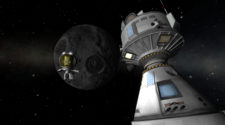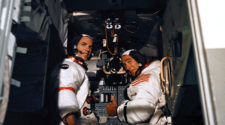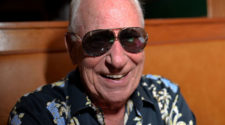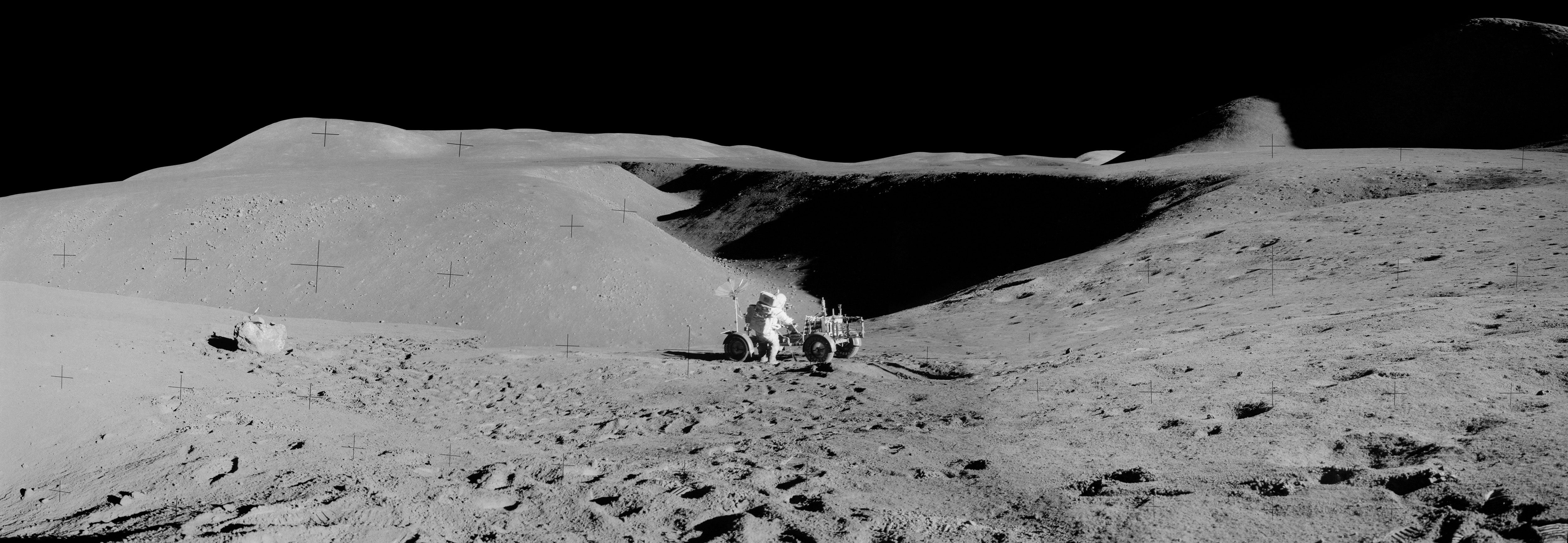
Premier of the J-series mission changed the game for Apollo 15
Four hundred miles (640 km) to the north of the Moon’s equator lies a place called Hadley: a small patch of Mare Imbrium at the base of the Apennine Mountains, some of which rise to 4,000 feet (1,200 meters), and a 25-mile (40 km) meandering gorge, known as Hadley Rille.
In July 1971, Apollo 15 astronauts Dave Scott and Jim Irwin expertly negotiated these forbidding landmarks in the lunar module Falcon and set down in one of the most visually spectacular regions ever visited by mankind. They brought back a scientific yield which revealed more about the Moon’s origin and evolution than ever before.
Forty-four years ago, this month in July-August 1971, Apollo 15 conducted one of the most brilliant missions ever undertaken in the annals of space science.
It is therefore ironic that this triumph actually arose from the ashes of defeat. Original plans called for four H-series lunar landing missions—Apollo 12 through 15—which would each spend 33 hours on the Moon and feature two EVAs. The final missions, belonging to the J-series, would perform longer missions, spend 70 hours on the surface, make three EVAs and utilize a battery-powered rover. In September 1970, everything changed when NASA canceled one H-series mission and one J-series mission; as a result, the schedule shifted to maximise the scientific harvest from the remaining flights. Apollo 15 was upgraded to the ambitious J-series and it was this decision which altered its scope and its place in history.
The countdown on 26 July 1971 was near-perfect. In fact, Launch Director Walter Kapryan described it as “the most nominal countdown that we have ever had”. The astronauts—Scott, Irwin and command module pilot Al Worden—were awakened early that morning, breakfasted on steak and eggs, caught a brief nap as they were being suited-up and were helped into their couches aboard the Apollo 15 command module, Endeavour, at around 7:00 a.m. EDT.
The clang of the hatch shutting them in startled Irwin. “I think that is when the reality of the situation hit me,” he later wrote in his memoir, To Rule the Night. “I realized I was cut off from the world. This was the moment I had been waiting for. It wouldn’t be long now.” From his couch on the right-hand side of the spacecraft, Irwin had little to do and had some brief respite to reflect on his life, consider the enormity of the mission ahead of him and, more than anything, give himself over to an air of anticipation and expectancy as he waited for the Saturn V to boost them toward the Moon.
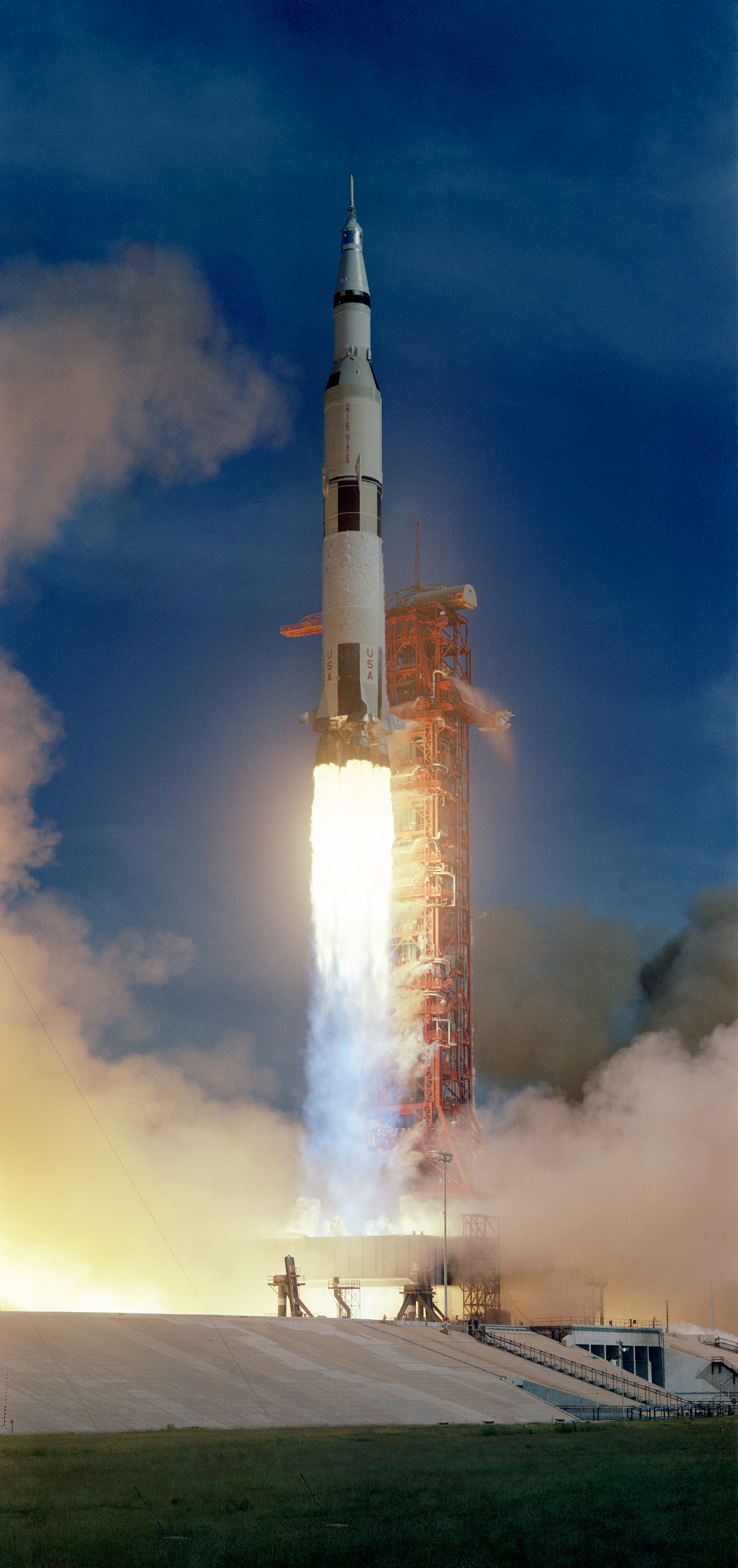
Fifteen minutes before launch, they had felt and heard the unearthly clanking noise of the access arm moving away from the spacecraft, then beheld the stunning blaze of sunlight through the command module’s only uncovered porthole. As the countdown entered its final seconds, the glare of the Sun was so intense that Scott had to shield his eyes, just to read the instrument panel in front of him. Precisely on time, at 9:34 a.m. EDT, the five F-1 engines of the Saturn V’s first stage came to life with a muffled roar. “You just hang there,” Irwin wrote. “Then you sense a little motion, a little vibration and you start to move. Once you realise you are moving, there is a complete release of tensions. Slowly, slowly, then faster and faster; you feel all that power underneath you.”
Four days later, after crossing the vast, 240,000-mile (370,000 km) cislunar gulf, Apollo 15 slipped into orbit around the Moon. Scott and Irwin, aboard the lunar module Falcon, undocked from Worden, in the command module Endeavour, and began their descent towards the surface.
Moving in a sweeping arc towards the Apennines, at an altitude of 4 miles (6.4 km), Scott began to discern the long, meandering channel of Hadley Rille. The terrain was less sharply defined than he had anticipated on the basis of simulations, yet he was able to find four familiar craters: Matthew, Mark, Luke and Index—the latter of which they had used in landmark sightings from orbit. (The name “Index” was deliberately chosen instead of “John” in order to stave off complaints from the notorious atheist Madalyn Murray O’Hair, whose criticism of overtly religious symbolic gestures on missions had scalded NASA during the December 1968 mission of Apollo 8.)
Dropping through a gap in the lunar mountains, Scott suddenly had the surreal feeling that he was “floating” with strange slowness towards his landing site. “No amount of simulation training,” he wrote in his memoir, Two Sides of the Moon, “had been able to replicate the view we saw out of our windows as we passed by the steep slopes of the majestic lunar Apennine Mountains.”
In the simulator, they “flew” a television camera towards a small, relatively flat patch of plaster-of-Paris; now, doing it for real, they drifted between the astonishing 16,400-foot (5,000-meter) peaks of the mountains to both their left and right as they threaded their way towards Hadley. “It made us feel,” he added, “almost as if we should pull our feet up to prevent scraping them along the top of the range.”
As they continued to descend, Falcon’s computer transitioned to the so-called “Program 66”, enabling Scott to fly manually.
“Dave didn’t want me looking at the surface at all,” Irwin wrote. “He wanted me to concentrate on the information on the computer and other instruments. He wanted to be certain that he had instant information relayed to him. He was going to pick out the landmarks. But Dave couldn’t identify the landmarks; the features on the real surface didn’t look like the ones we had trained with.”
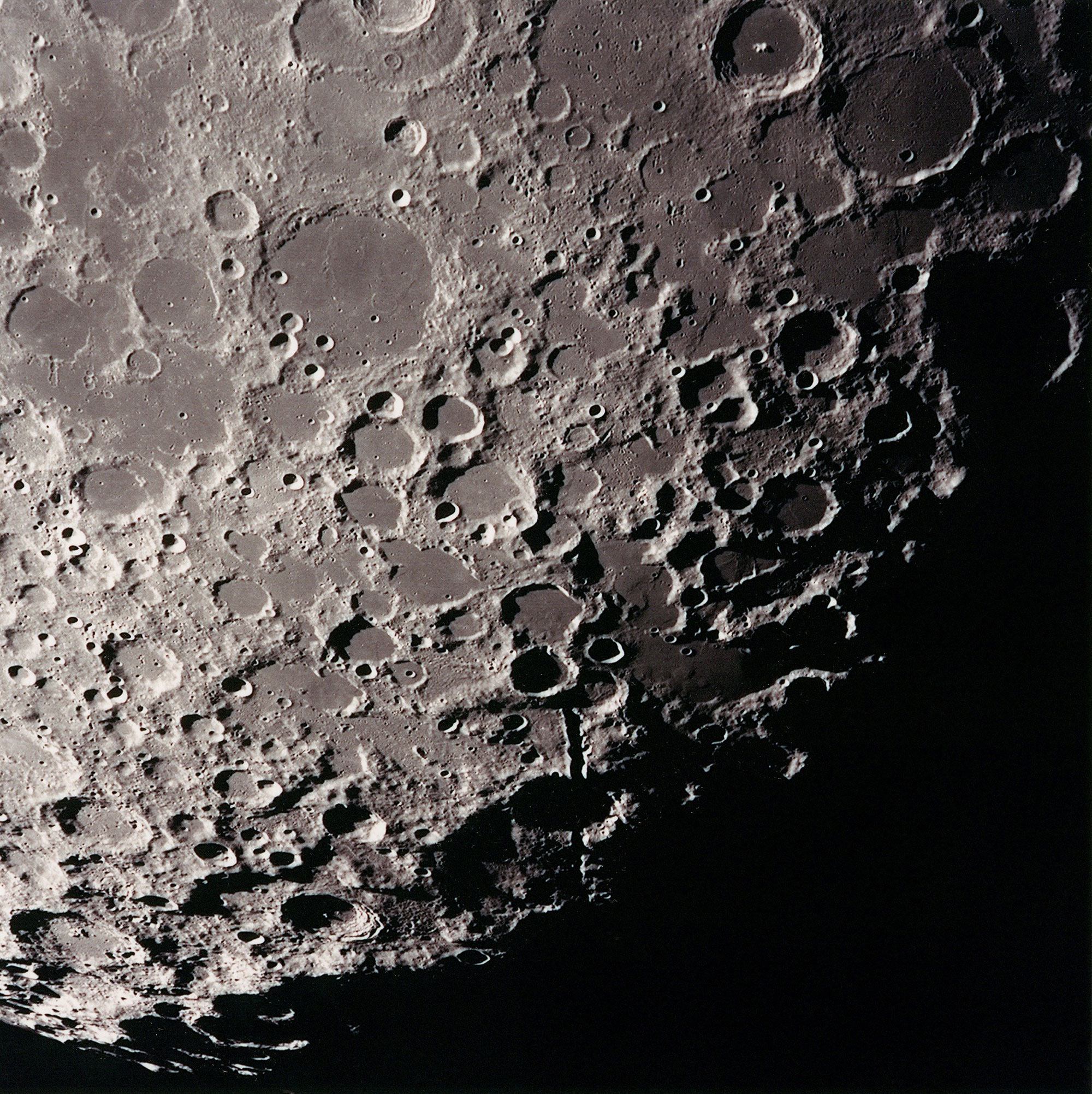
Scott could see Hadley Rille, though, and used that long gouge as his marker, but was worried that they might still land “long”, and far to the south of their intended spot. This fear was confirmed by Capcom Ed Mitchell; they were, indeed, 0.5 miles (0.8 km) or more south of track. Scott knew that, even with the rover, this might impair the effectiveness of their explorations.
During those final moments, he clicked his hand controller 18 times, forward and to the side, adjusting their trajectory to bring Falcon back onto its prescribed path.
Those seconds were so unreal—the clarity of the scene, the weird behavior of the lunar dust, the strange, almost-unpowered sense of drifting like a snowflake through the majesty of the lunar mountains—that Irwin mentally convinced himself that he was still in the simulator back in Houston. If he had admitted to himself that this was for real, he felt that he would have been just too excited to do his job properly. Yet if this was a simulation, it was one of the smoothest that he had ever flown. They were very close to the surface now and lunar dust obscured the landing site entirely, like a thick fog.
It was only Irwin’s call that the blue Contact Light had illuminated which finally convinced them that they had touched down. The time was 6:16 p.m. EDT on 30 July 1971 and, with a firm thud, the seventh and eighth men from Earth reached the surface of the Moon. “Okay, Houston,” radioed Scott, “the Falcon is on the Plain at Hadley!” His reference to the landing site as a “plain” paid due tribute to Scott’s alma mater, the Military Academy at West Point, whose parade ground was also nicknamed “The Plain”.
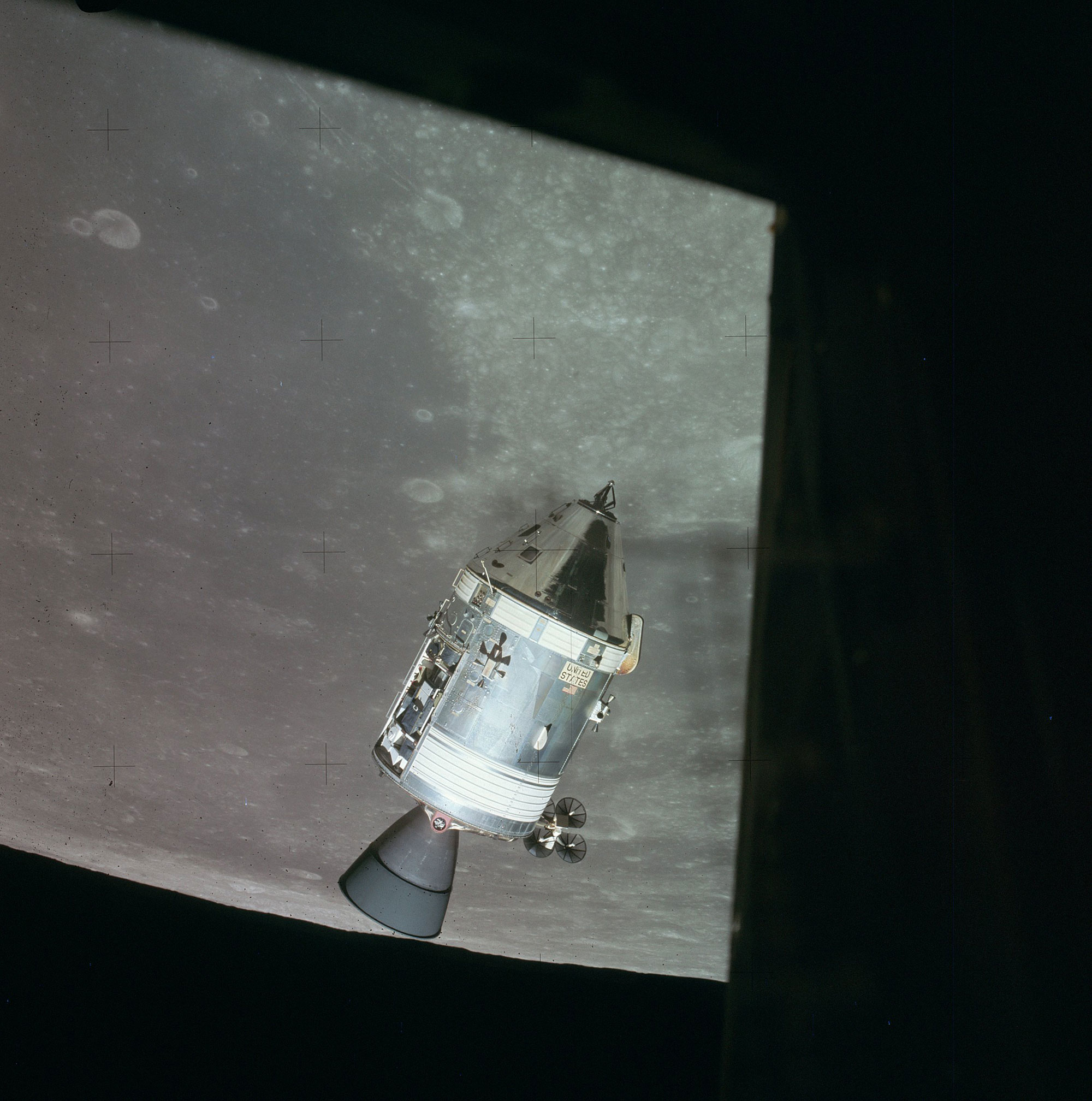
What did cause concern was that Falcon had come down on uneven ground and one of its rear footpads had planted itself inside a small crater. (Mission Control would later call their lander “The Leaning Tower of Pisa”, an epithet which Scott did not appreciate!)
Irwin remembered the landing as the hardest he had ever been involved in; “a tremendous impact with a pitching and rolling motion. Everything rocked around and I thought all the gear was going to fall off. I was sure something was broken and we might have to go into one of those abort situations. If you pass 45 degrees and are still moving, you have to abort. We just froze in position as we waited for the ground to look at our systems. They had to tell us whether we had a STAY condition”.
With some relief, 77 seconds after touchdown, Mission Control radioed their approval for Scott and Irwin to STAY.
“The excitement was overwhelming,” Irwin wrote, “but now I could let myself believe it.” They had set down in a beautiful valley, with the mountains of the Apennines on three sides of them and Hadley Rille about a mile (1.6 km) to the west. In his mind, it conjured up memories of the mountains of Colorado, high above the tree line; yet there was something else about it, too.
Irwin was certainly one of the more religious men in the astronaut corps and he would later make little secret of the fact that he acutely sensed the presence of a supreme being on the Moon. This sensation reached its sharpest whenever he looked up at the colorful Earth in the black sky. “That beautiful, warm living object looked so fragile, so delicate, that if you touched it with a finger it would crumble and fall apart,” he wrote. “Seeing this has to change a man, has to make a man appreciate the creation of God and the love of God.” This profound experience would remain with Irwin and guide his steps for the rest of his life.
One of the skills that Scott learned during his geology training was the need to gain a visual perspective of the site that he was about to explore. With this in mind, he requested mission planners to schedule a “stand-up EVA”, a couple of hours after touchdown, in which he would stand on the ascent engine cover, poke his helmeted head through Falcon’s top hatch and photograph his surroundings.
At first, Director of Flight Crew Operations Deke Slayton opposed the idea, on the grounds that it would waste valuable oxygen, but Scott fiercely argued his case and eventually won approval.
To conduct this half-hour “SEVA”, Scott pulled a balaclava-like visor over his clear bubble helmet, clambered onto the ascent engine cover and removed the top hatch. It was, he wrote, “rather as if I was in the conning tower of a submarine or the turret of a tank”. Meanwhile, Irwin shaded the instrument panel from the unfiltered lunar sunlight and arranged Scott’s oxygen hoses and communications cables to enable him to stand upright. “He offered me a chance to look out,” Irwin wrote, “but my umbilicals weren’t long enough and I didn’t want to take the time to rearrange them.”
In the weak gravity, Scott found that he could easily support himself in the hatch on his elbows…and beheld the stunning view of the brown-and-tan Apennines, tinged by the intense golden sunlight, against black sky. Irwin passed up a bearing indicator and a large orientation map, which Scott used to shoot a couple of dozen interconnected stereo pictures of the landing site now officially known as “Hadley Base”.
As his eyes adapted, and his mind connected it with months spent examining Lunar Orbiter geology maps, Scott began reeling off the landmarks. There was Pluton and Icarus and Chain and Side—intriguing craters in an area known as the “North Complex”—and on the lower slopes of Mount Hadley Delta was the vast, yawning pit of St. George Crater.
One particularly prominent, rocky landmark which they had dubbed “Silver Spur” in honor of their geology professor, Lee Silver, showed clear evidence of stratigraphy in its flanks.
“The SEVA was a marvelous and useful experience, for a lot of reasons,” Scott later explained for the Apollo Lunar Surface Journal. “One of our problems at Hadley was that the resolution of the Lunar Orbiter photography was only 60 feet (18 meters), so they couldn’t prepare a detailed map. The maps we had were best guesses and we had the radar people tell us before the flight that there were boulder fields…all over the base of Hadley Delta. So another reason for the stand-up EVA was to look and see if we could drive the Rover, because if there were boulder fields down there, and nobody could prove there were no boulder fields, it changed the whole picture.”
The view set his mind at ease; it looked totally unhostile and contradicted pre-flight fears. The “trafficability” as Scott put it, would be excellent.
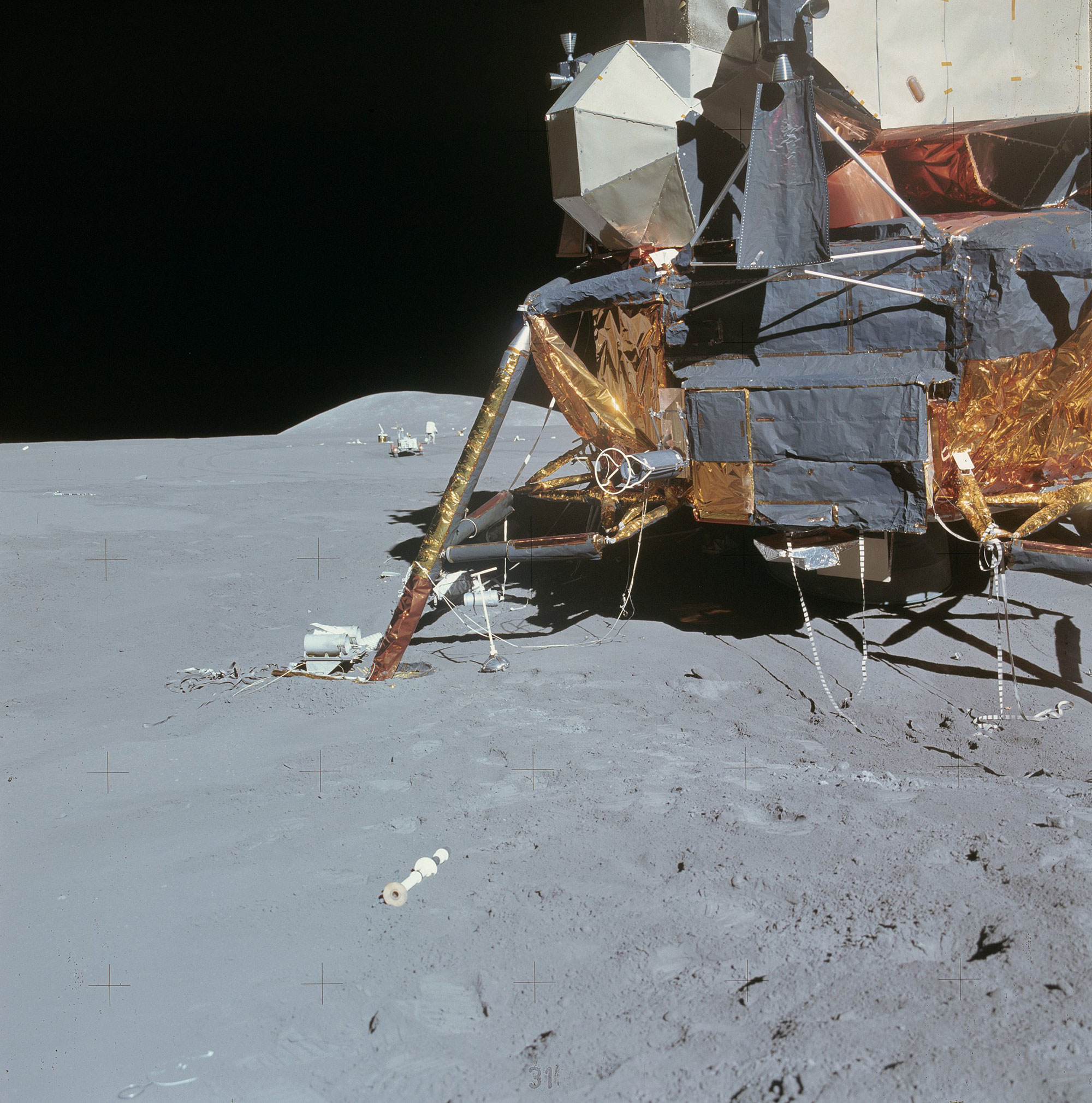
Back inside Falcon, acutely aware that they were the only inhabitants of Earth ever to visit this barren place, the astronauts removed their suits and set about preparing their evening meal and getting ready for sleep. “Tomato soup was big on the menu, as I recall,” Scott wrote. “There was no hot-water supply in the LM, as there was in the command module, so all our meals on the lunar surface were served cold and we soon discovered that there was not really enough to eat, either.”
In the coming weeks, they would recommend that more food be carried on Apollo 16 and 17, for walking on the Moon required huge reserves of energy and stamina and would prove to be hungry work.
Irwin, too, remembered Apollo 15’s staple of soups. “Eating them required some acrobatics,” he wrote. “They were…in plastic bags, but they had a Teflon seal that you had to peel off. We added water to the soups, then very carefully pulled the tab to open them up. If you opened them slowly, invariably the soup would start coming out in bubbles or blobs that would float all over the place. The trick was to open the bag fast, so that the viscosity or capillary action would encourage the soup to adhere to the plastic. The object was to take advantage of whatever adhesiveness the soup had.” When it had been thus “contained”, they could eat quite normally, with a spoon, directing it approximately towards their mouths.
Sleeping in their long johns, without the bulky space suits, was more comfortable in one-sixth gravity than it had been in pre-launch rehearsals. It felt very much like a water bed, Irwin wrote, and they felt as light as feathers in the weak lunar gravity. They popped in earplugs, pulled down the blinds over the two triangular windows and drifted into a fitful sleep. Scott arranged his hammock in a fore-to-aft direction above the ascent engine cover, whilst Irwin stretched “athwart ship”.
Despite having long since accepted being here, Scott still succumbed to the temptation to raise the blind and take a long look at the astonishing panorama beyond Falcon’s windows, and called on Irwin to come and take a look. There was, however, little time to wonder and the strictness of the timeline forced them to begin preparations to put on their suits for the first of three Moonwalks.
Irwin would subsequently relate, with a hint of humor, that he and Scott did more talking to one another during the donning of the suits than they had in the past several days. With all the added bulk of a backpack, oxygen and water hoses and electrical cabling, and with the suit fully pressurized, Scott found it surprising that he actually fitted through Falcon’s small, square hatch when the time finally came to venture outside.
It had become something of a tradition by now for each Apollo commander to make a meaningful comment when he took his first steps on the Moon. Dave Scott’s historic handful of words at 9:29 a.m. EDT on 31 July were entirely appropriate for a man who had started out as a fighter pilot and had been steadily won over by the wonders of geology.
“As I stand out here in the wonders of the unknown at Hadley,” he said as he gazed in wonderment at the Apennines, “I sort of realize there’s a fundamental truth to our nature. Man must explore…and this is exploration at its greatest!”
With a squeeze, and almost falling onto his backside in the lunar dust, Irwin quickly joined Scott and the two men set to work deploying the rover from its berth in Falcon’s descent stage. To do so, they tugged on a series of pulleys and braked reels and it required both of them, working in tandem. As it flopped into the lunar dust, the rover was secured with pins.
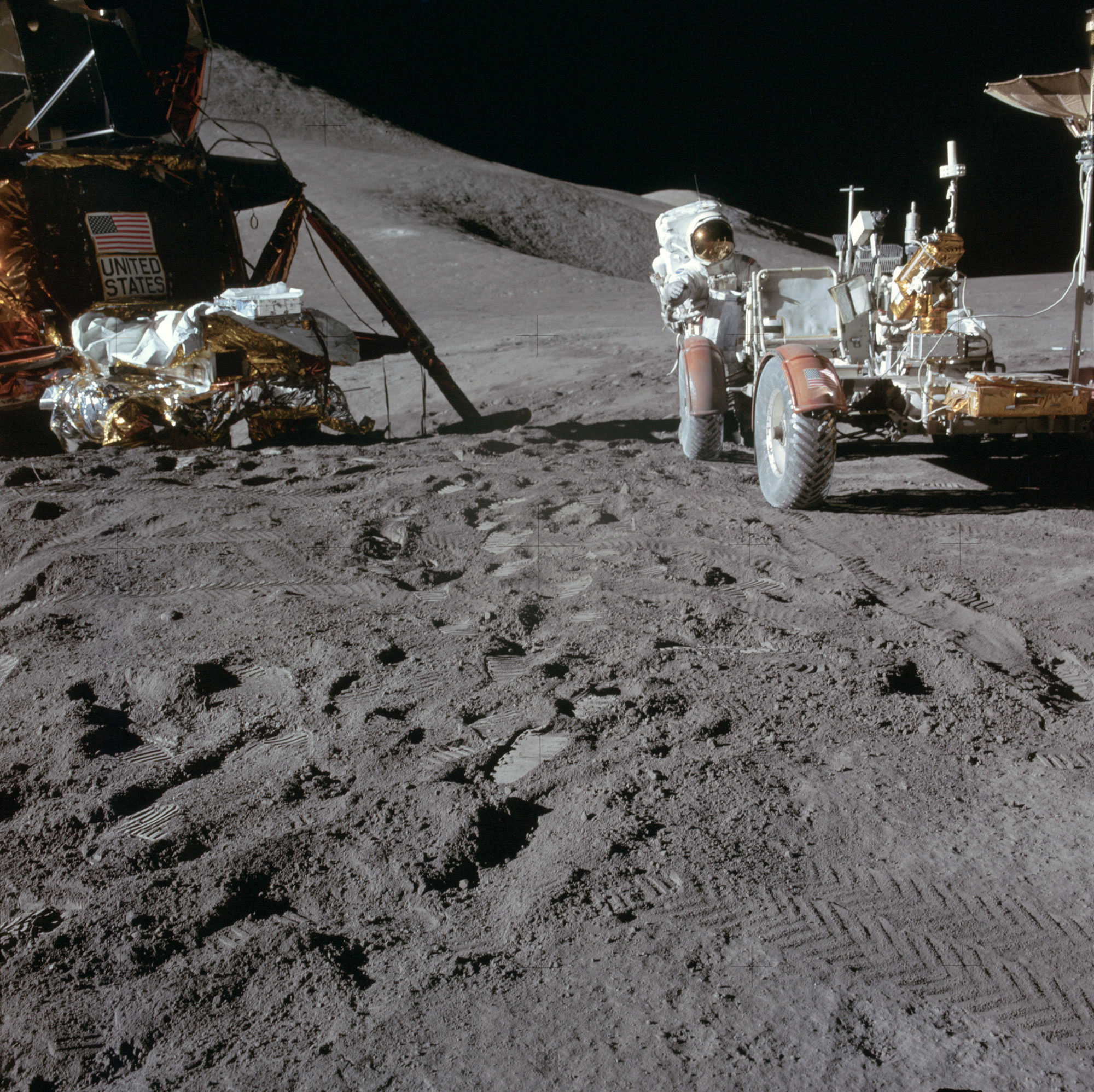
Scott clambered aboard to give it a test drive and found a minor problem: the front steering was inoperable, so they would have to rely on rear-wheel steering instead. After installing the color television camera and loading up the geology tools, they buckled themselves aboard and set off.
It must have been a peculiar sight for any onlooker to see this space-age dune buggy bouncing across the lunar surface; even at top speeds of just 5-6 mph (8-9.5 km/h), it was a bouncy ride and if the rover hit a rock, it literally went airborne for a couple of seconds. Irwin later likened it to a bucking bronco or an old rowing boat on a rough lake.
“I’ve never liked safety belts,” he wrote, “but we couldn’t have done without them on the rover. You could easily get “seasick” if you had any problem with motion.” In fact, Irwin’s seat belt turned out to be too short and before they could set off Scott had to come around to his side of the rover to buckle him in properly. “We didn’t realize,” Irwin explained, “when we made the adjustments on Earth, that at one-sixth-G the suit would balloon more and it would be difficult to compress it enough to fasten the seat belt.”
The “real” rover was also slightly different to drive than the one in which the men had trained on Earth. From his seat, Scott found that he had to concentrate all of his energies simply driving and keeping track of craters—the harsh glare of sunlight made the terrain appear deceptively smooth, literally “washing-out” surface features, and hummocks and furrows appeared out of nowhere, at a split-second’s notice. Its maneuverability was good (“it could turn on a dime,” Scott recalled), but its wheels kicked up enormous rooster-tails of dust, which were thankfully deflected by its fenders.
As the navigator, Irwin tried to plot their course on the map, but had difficulty identifying their route because they were uncertain of precisely where they had set Falcon down.
However, Mount Hadley Delta was clear to see, with St. George Crater—an enormous gouge the size of two dozen football fields—on the lowermost slopes and all they had to do was drive with it on their port quarter and they knew that eventually they would come upon the rille.
Cresting the top of a ridge, they were rewarded with their first unearthly glimpse of Hadley Rille and gained a clear awareness of its enormous size.
Half an hour after leaving Falcon, they made their first scheduled halt at a place called “Elbow Crater”, right on the rim of the rille at the base of the mountain. From here, Scott took a series of pictures of the far side of Hadley Rille, whose interior wall showed clear evidence of layering in outcrops not far below its rim, and the two men took a few minutes to gather samples.
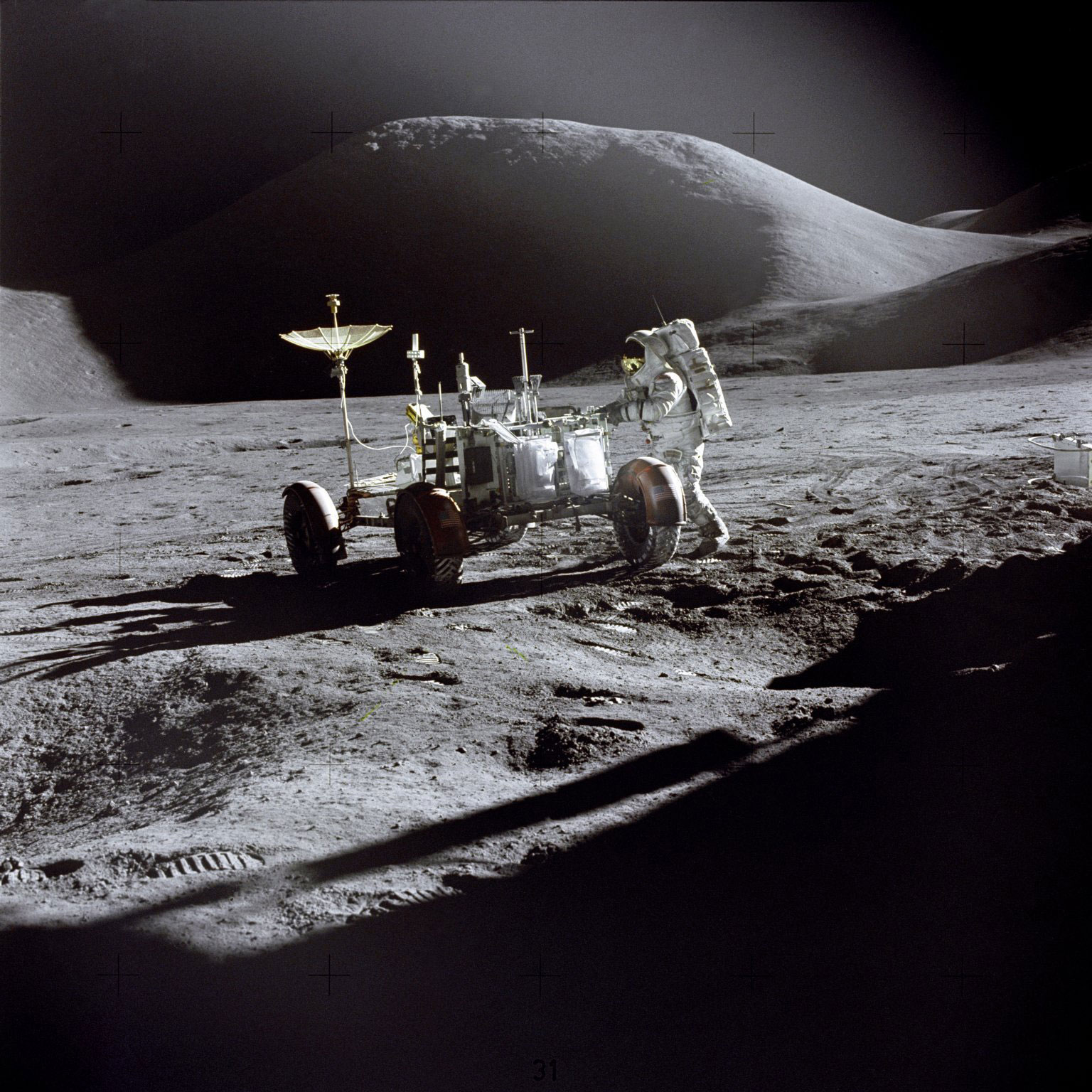
Next, they set off towards the rim of St. George Crater. It had been expected that the area would be littered with large blocks of rock, but upon finding the flank of the mountain remarkably clean, Scott decided to halt short of the rim and sample an isolated boulder. It was more than 3.3 feet (1 meter) across and its “half-in-half-out” nature, part-buried in the soft soil.
Simply walking was as strange as the world upon which they were now operating. It felt, Irwin explained, very much like walking on the surface of a trampoline, although the bulk of the space suit made it virtually impossible to move in a natural, Earthly gait. “When you don’t have the weight of your legs available to push against the suit,” he wrote, “you are constrained as to how far you can move. Consequently, you just use the ball of your foot to push off. That’s why we looked like kangaroos when we walked. We flexed the boot and that pushed us forward.”
“One of the Moon’s most striking features,” Scott related, “was its stillness. With no atmosphere and no wind, the only movements we could detect on the lunar surface, apart from our own, were the gradually shifting shadows cast to the side of rocks and the rims of craters by the Sun slowly rising higher in the sky.”
There was absolutely no trace of anything which exhibited either life or color or movement and the only sound came from the gentle hum of life-sustaining machinery in their backpacks, the hiss of the air flowing through their suits, or the crackle of each other’s voices or the voice of Houston in their earpieces.
The problem of judging distances had been noted by earlier crews. “There’s nothing of scale which is familiar,” Scott told the Apollo Lunar Surface Journal. “There are no trees, there are no cars, there are no houses…and, as an example, we all know what size trees are in general. There are no trees and there’s nothing in the landscape that has any familiarity. There’s no “hook”. So when you look out there, you see boulders, but you can’t really tell whether it’s a large boulder at a great distance or a small boulder nearby. If it’s very nearby, it’s easy because you can run out along the ground and start calibrating your eyes. If you’re looking close to the LM, you know what three or four inches are, but as you start going out, you start losing your perspective, because there’s nothing to measure out there. It’s a very interesting phenomenon that everybody gets fooled on these distances.”
Having said this, Scott added that the tracks of the rover lent some indication of distance. “Once you have some tracks,” he said, “you can start seeing things. As an example, up on the side of Hadley Delta, looking back at the Lunar Module, boy, it was small!”
In the absence of an atmosphere or the slightest trace of haze, Falcon appeared far closer and far smaller than it actually was. “But it gives you a scale of how far away it is,” Scott concluded. Even decades later, Scott expressed frustration with his inability to describe how it felt: the ability of his eyes and how well they transmitted images to his brain was good on the Moon. Yet there was nothing on Earth to compare with it.
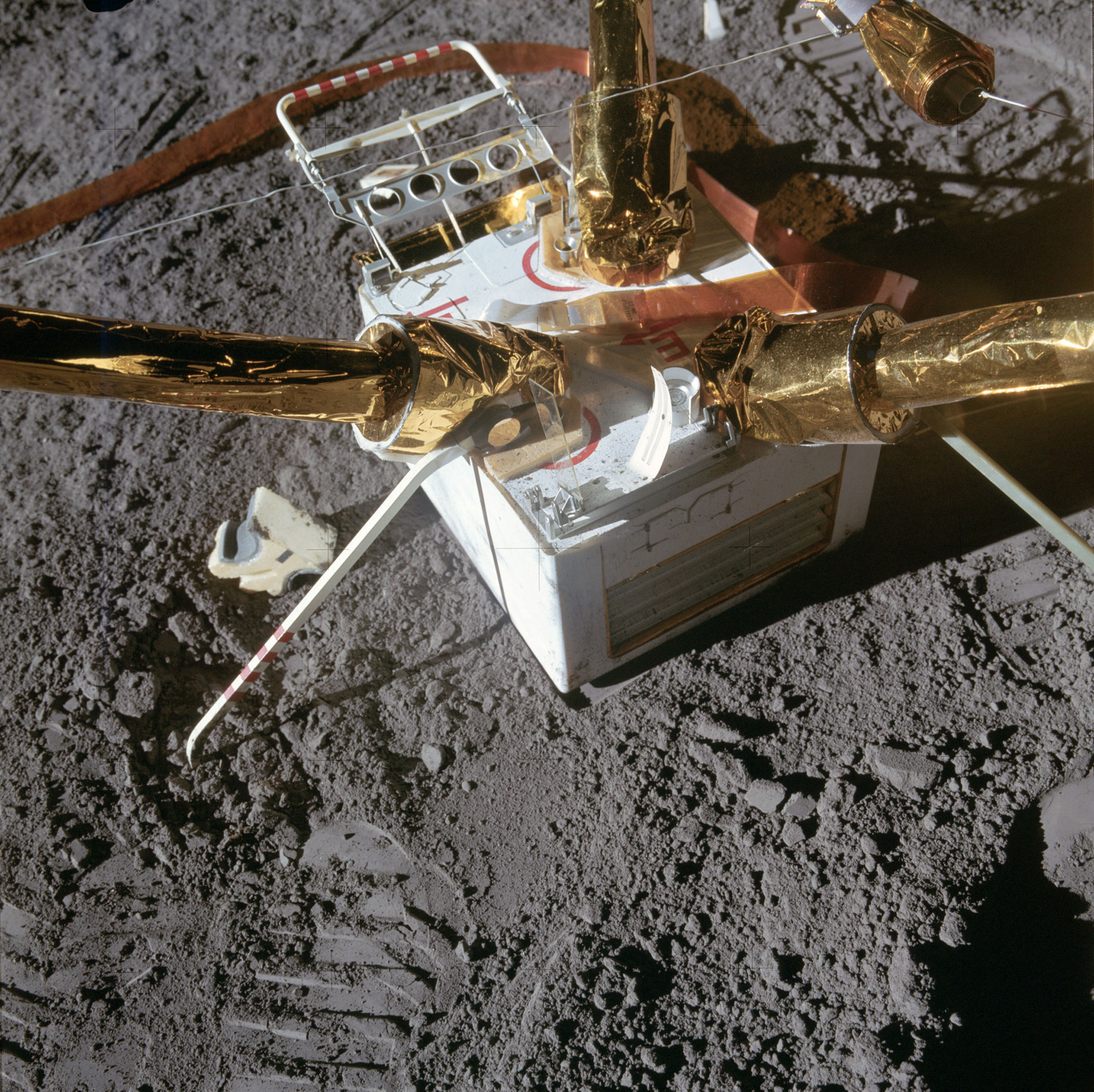
Heading back towards Falcon after a little more than two hours, the two men could take great pride in their achievements so far. Yet they still had a sizeable portion of work to do before returning inside. Of primary importance was the assembly of their Apollo Lunar Surface Experiments Package (ALSEP).
Scott picked a spot a few hundred feet from the lander and Irwin lugged it over, one pallet on each end of a carrying bar, not dissimilar to a giant dumbbell. On his cuff checklist, Irwin checked a small “map” of where each component was supposed to go. Meanwhile, Scott was experiencing his own problems.
One of the ALSEP’s experiments was the heat-flow investigation. This had been assigned to the ill-fated Apollo 13 mission, but never made it to the Moon. It required Scott to use a small, box-like drill to bore a couple of deep holes into the surface and emplace a pair of temperature probes. He would then drill a third hole for a core sample.
He made excellent progress on the first hole, reaching a depth of about 1.6 feet (0.5 meters), then met a hard subsurface. Despite leaning on the drill to give it extra bite, he fell behind schedule and was advised to insert the first set of probes. The second hole proved even more difficult, and Mission Control called a halt with the drill only a couple of feet into the ground. Capcom Joe Allen told Scott to take a breather, then help Irwin with deploying the retroreflector and a solar-wind experiment. They would have to complete the drilling later.
Their first Moonwalk ended slightly earlier than planned, after 6.5 hours.
Back inside Falcon, both men were exhausted. The stress of driving and the toughness of handling the drill for the heat-flow experiment had worn out Scott’s hands and forearms. Irwin described the pain in his fingers as excruciating.
They took each other’s gloves off to inspect the damage: perspiration poured from them, but there was no evidence of bleeding or bruising. Then they realized that their fingernails, which had grown during the last five days, had been immersed in sweat for the last seven hours. To aid movement, their gloves had been designed to fit tightly against the tips of their fingers; the pressure and the pain was on the ends of the nails.
Irwin resolved to cut his nails and advised his commander to do the same, but for some reason—perhaps fearful that it might compromise his own dexterity on the surface—Scott declined.
Irwin was also uncomfortable. A problem with his drinking water bag had left him absolutely parched for more than seven hours. “There was a nozzle that you’d bend down to open a valve so you could suck the water out and drink it within the protection of the space suit,” he explained, “but I could never get my drink bag to work and I never got a single drink of water during the whole time I was out on the surface of the Moon.” He did, however, manage to gobble down a fruit stick inside his helmet…and that helped him to keep going when the time came to assemble the ALSEP.
Now, having doffed his suit, Irwin guzzled water like a jogger, then settled down with Scott for their second night on the Moon. “Settled” probably was not an appropriate word, for conditions inside Falcon cannot have been pleasant: with the presence of all the rocks and soil specimens, the smell of the Moon—a strong, gunpowder-like aroma—pervaded the air and dust covered everything. They stashed their filthy suits at the back of the cabin, making sure that the gloves were fitted, so as not to impair their seals, then debriefed to Houston and bedded down for their second night’s sleep on the Moon.
The next two EVAs would bring tremendous scientific discoveries, which continue to resonate to this day.
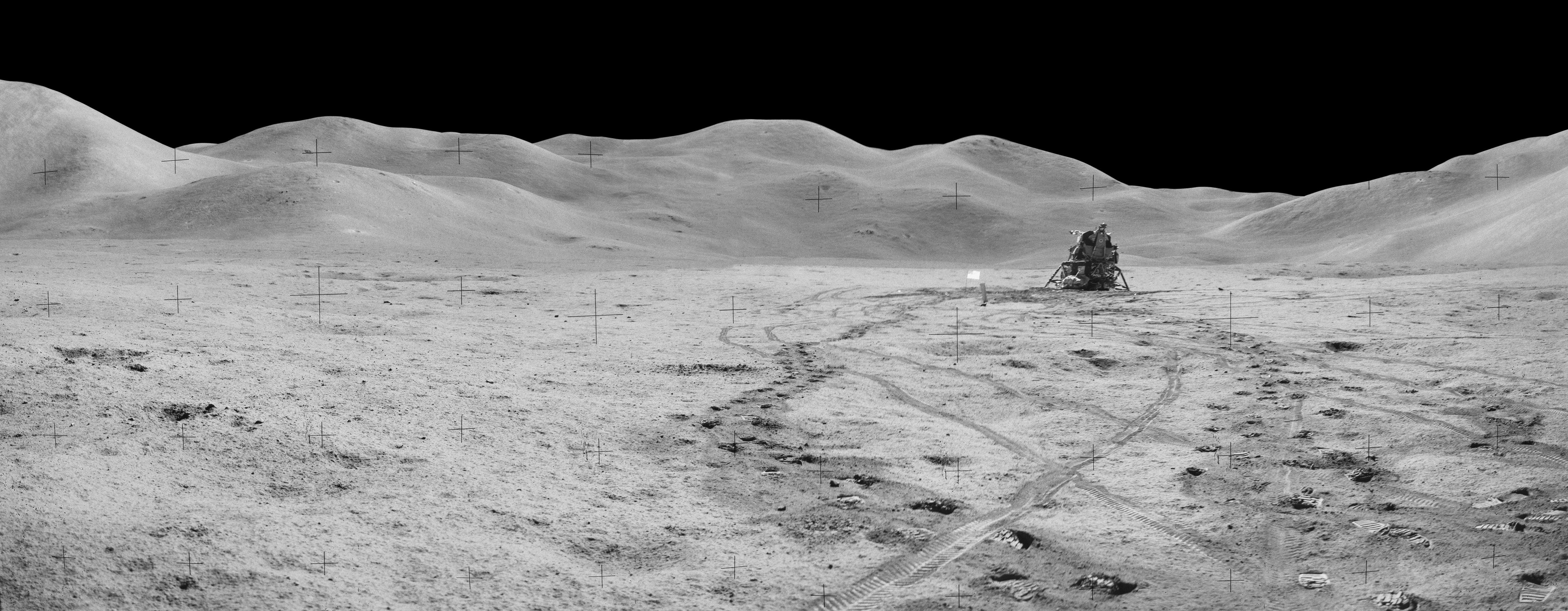
Credit: NASA via Retro Space Images
Early on 1 August, Capcom Gordon Fullerton woke Scott and Irwin with some unwelcome news. Two days earlier, the lunar module Falcon had touched down at a slight angle—one of its legs had set down in a crater—and this had caused it to lose a sizeable amount of water. Fullerton asked the men to check behind the ascent engine cover. He was right and the astronauts quickly scooped it into a spent lithium hydroxide canister.
Scott and Irwin’s second Moonwalk was slightly shorter than their first, in order to provide more exploration and less traveling time between geological stops. One relatively low-priority activity had been eliminated and a greater measure of freedom was given to the efforts of the astronauts; Mission Control and the geologists in Houston would depend heavily upon their descriptions and observations and it would be Scott and Irwin’s choice on exactly where they chose for their major sampling.
“We’re looking now, primarily, for a wide variety of rock samples from the [Apennine] Front,” Capcom Joe Allen told them. “You’ve seen the breccias already. We think there may very well be some large crystal[line] igneous [rocks] and we’d like samples of those and whatever variety of rocks which you’re able to find for us—but primarily a large number of documented samples and fragment samples.”
Scott was in full agreement; Allen was talking their language and after two years of geological training he felt ready and confident to explore.
A few minutes before 9:00 a.m. EDT on 1 August 1971, safely buckled aboard the lunar rover, the astronauts set off due south, heading for Mount Hadley Delta, upon whose slopes they would concentrate their energies.
It was a scenic trip, Irwin recalled in his memoir, To Rule the Night. Ahead of them, and all around them, the terrain was literally splattered with craters, right up the slopes of Hadley Delta, and the height of the mountain rivaled the tallest peaks of the Rockies. After passing the vast cavity of Dune Crater, whose rim was littered with large blocks, they started up the mountain.
On the plain the going had been rough, but on the slope the surface smoothed out markedly. Near Spur Crater, they swung left and drove across-slope.
Looking downslope, they were astonished to realise how far they had come. The lander was a tiny speck on the undulating plain and the astronauts were now at an elevation of about 350 feet (106 meters). The view, completely unhindered by atmosphere or haze, almost knocked Dave Scott’s socks off.
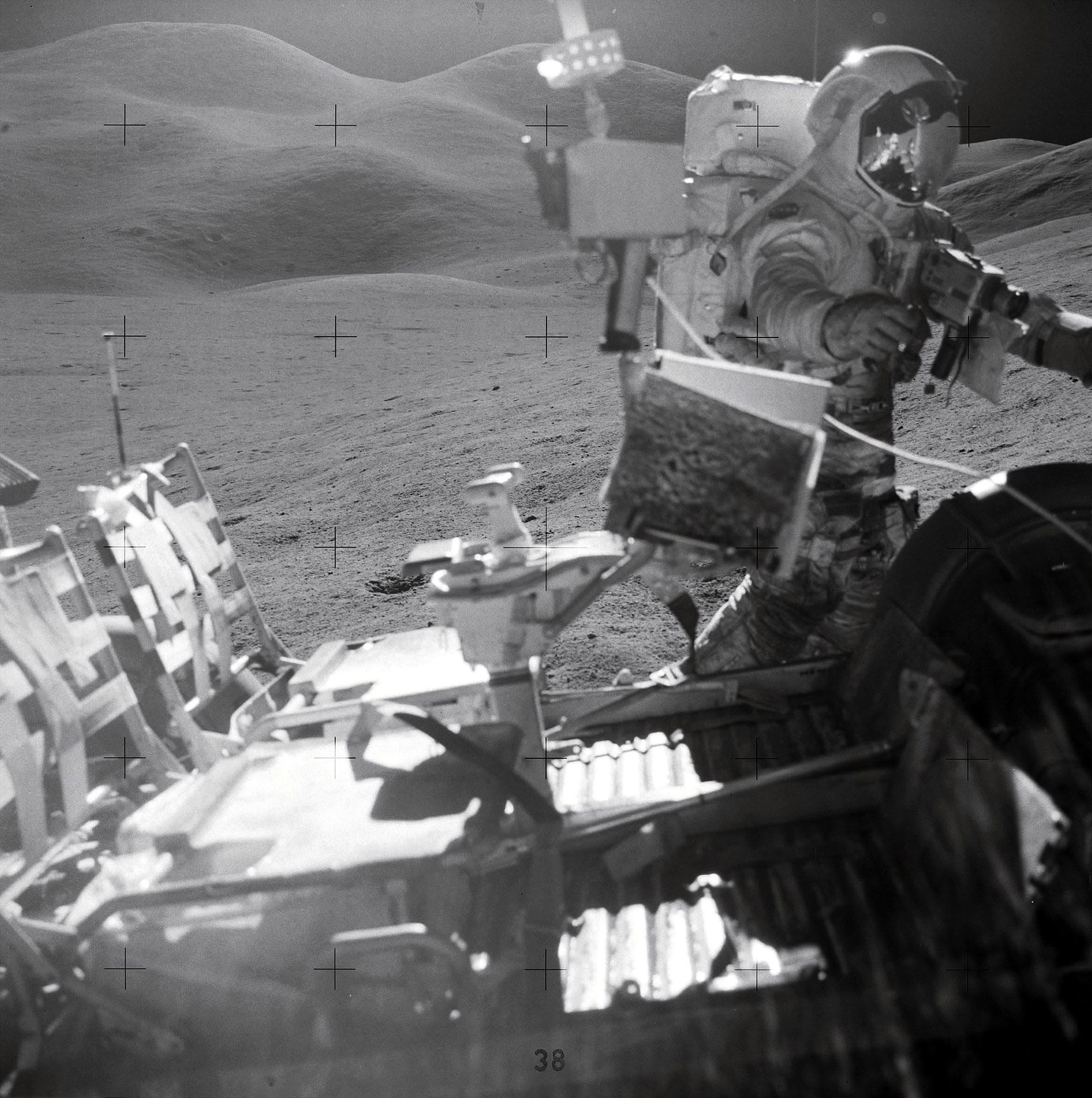
Their first task was to find a small “drill hole” crater that could have excavated material from the mountain, but the flank was remarkably clean.
Scott curtailed the planned drive and they sampled a small crater and then an isolated boulder which was coated in greenish material.
The green hue captivated Jim Irwin, whose Irish descent and birthday on St. Patrick’s Day—and the fact that he had stowed some shamrocks in the lunar module—made this a special find.
At first, the two men wondered if their eyes or Sun visors were playing tricks on them, but when it was unpacked a few weeks later in the Lunar Receiving Laboratory (LRL), their initial impressions would be confirmed: it was green, made entirely of minuscule spheres of glass, tiny droplets of magma spewed from a fissure by a “fire fountain”.
In time, it and other samples would contribute to making Apollo 15 one of the greatest voyages of discovery ever undertaken in human history.
Finally, they headed for Spur Crater. “As soon as we got there,” Irwin described, “we could look over and see some of this white rock. Immediately, I saw white, I saw light green and I saw brown. But there was one piece of white rock that looked different from any of the others. We didn’t rush over to it; we went about our job the usual way. First I took down-Sun shots and a locator shot about 45 degrees from the Sun-line and Dave took a couple of cross-Sun shots.”
Scott and Irwin slowly threaded their way between the craters to the strange white rock. “It was lifted up on a pedestal,” Irwin wrote. “The base was a dirty old rock covered with lots of dust that sat there by itself, almost like an outstretched hand. Sitting on top of it was a white rock almost free of dust. From four feet away I could see unique long crystals with parallel lines, forming striations.” Scott used tongs to pick it up and held it close to his visor to inspect it. The rock was about the same size as his fist and even as he lifted it, some of its dusty coating crumbled away…and he saw large, white crystals.
“Aaaahh!” he exulted.
“Oh, man!” added Irwin.
The rock was almost entirely “plagioclase”—an important tectosilicate feldspar mineral used by petrologists on Earth to help determine the composition, origin and evolution of igneous rocks—and from their expeditions into the hills of the San Gabriels, Scott recognized it as “anorthosite”, which is the purest form of plagioclase.
For some time, lunar geologists had suspected that anorthosite formed the Moon’s original, primordial crust; indeed, data from the unmanned Surveyor 7 lander had suggested its presence in the ejecta of the crater Tycho and tiny fragments of it had actually been found in samples from both Apollo 11’s landing site at Tranquility Base and Apollo 12’s site in the Ocean of Storms.
“Explaining why most of the Moon’s crust should be composed of anorthosite,” wrote Andrew Chaikin in A Man on the Moon, “led some geologists to an extraordinary scenario. Within the infant satellite, they proposed, there was so much heat that the entire outer shell became an ocean of molten rock. As this “magma ocean” cooled, minerals crystallized. The heavier species, including the iron- and magnesium-rich crystals, sank to the bottom. The lighter crystals, specifically, the mineral [aluminium-rich] plagioclase floated to the top.”
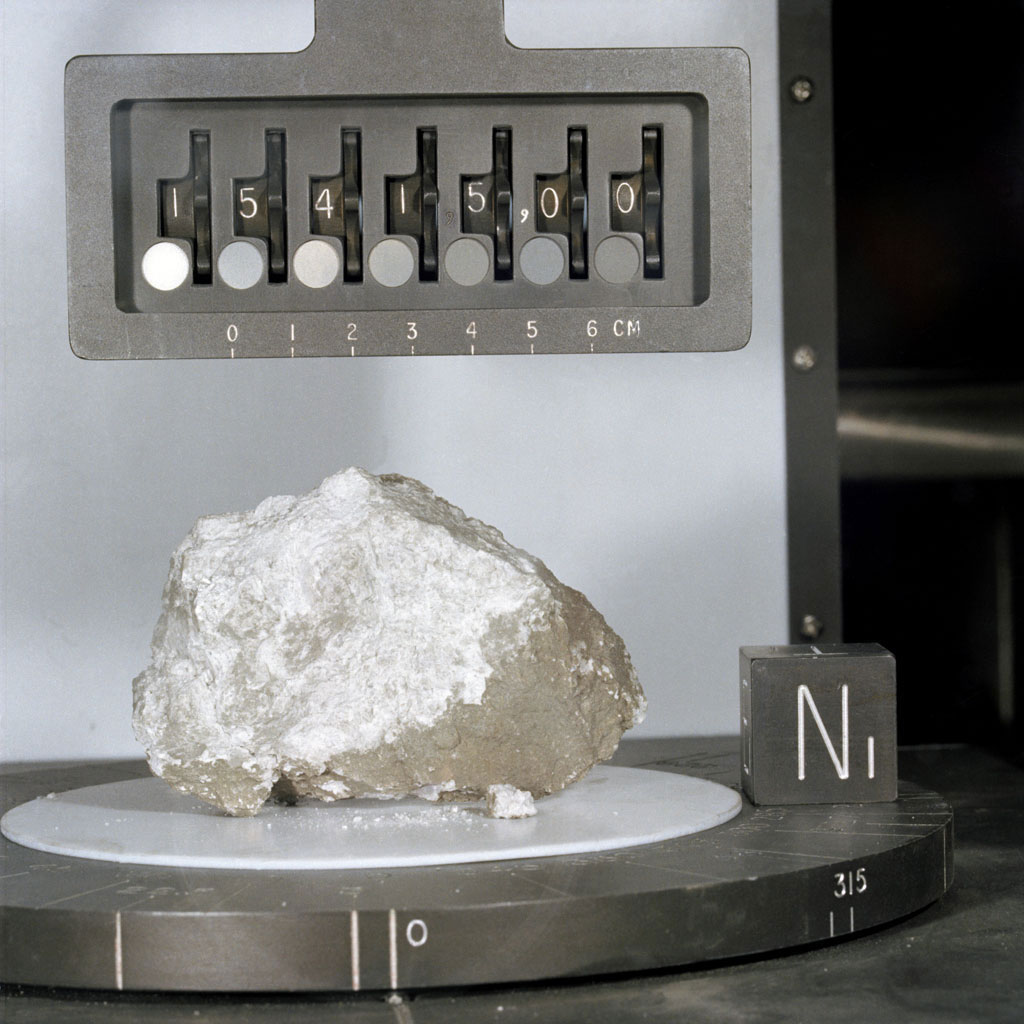
Recognizing the find as probably a piece of the Moon’s primordial crust, Scott could hardly contain his enthusiasm. “Guess what we just found!” he radioed. “I think we just found what we came for!”
“Crystalline rock, huh?” said Irwin.
“Yessir,” replied Scott.
After briefly describing the rock’s appearance, Scott placed it into a sample bag by itself. It would be labeled as sample number 15415, but a keen journalist, inspired by the term “petrogenesis”, the study of the origin of igneous rocks, would later offer it a far more lofty title: “The Genesis Rock”, a sample of the original lunar crust, coming from one of the earliest epochs of the Moon’s history, some 4.1 billion years ago.
This date was reached by geologists at the University of New York at Stony Brook and proved to be almost 1.5 billion years older than the oldest rocks found on Earth. If the Moon was any older than that, noted Chaikin, it wasn’t much older; the Solar System itself was thought to have formed only a few hundred million years earlier.
Back in the vicinity of Falcon, shortly before 2:00 p.m. EDT and five hours into their second Moonwalk, Scott and Irwin had other chores to finish; first, there was the need to complete drilling the heat-flow hole which had hit resistant soil the previous day.
Scott had already noticed inside the lander that his injured fingers were starting to turn black and so had to summon as much strength as he could muster—bringing his hands right up close to his chest just to squeeze the drill’s trigger—to complete the task. He could physically stand only about a minute of the pressure on his fingernails, before breaking off for a breather. At length, both sensor packages were in place to a depth of about 5 feet (1.5 meters).
However, when Scott attempted to extract the core sample which, at about 8 feet (2.4 meters) long, was the deepest such sample yet attempted on the Moon, he managed to lift it slightly, but it refused to budge any further. Joe Allen told him to leave it until tomorrow’s final excursion.
Meanwhile, Irwin dug a trench and used a penetrometer to test the bearing strength of its walls and floor. “If you think digging a ditch is dog’s work on Earth,” he wrote, “try digging a ditch on the Moon. The big limitation is the suit and the fact that you are clumsy at one-sixth-G. I had practiced on Earth and come up with a technique that most dogs use. You spread your legs and push the dirt between them. I solved a dog’s job with a dog’s technique. This method worked perfectly on the Moon.”
He easily dug through a fine grey material which he likened to talcum powder, and then a coarser, darker soil, but had to give up on reaching a very resistant layer which, although it looked moist, had all the consistency of hardpan.
They wrapped up the second Moonwalk by planting the American flag and loading that day’s rock box aboard Falcon. Not only had most of the equipment operated flawlessly, but the live—and color—images provided by the Earth-operated television camera on the rover was a far cry from the crude black-and-white pictures of Apollo 11.
Furthermore, Scott and Irwin had truly done their mentor, Lee Silver, proud through their geological descriptions. “I’m told,” Joe Allen radioed, “that we checked off the 100-percent science completion square time during EVA-1 or maybe even shortly into EVA-2. From here on out, it’s gravy all the way!”
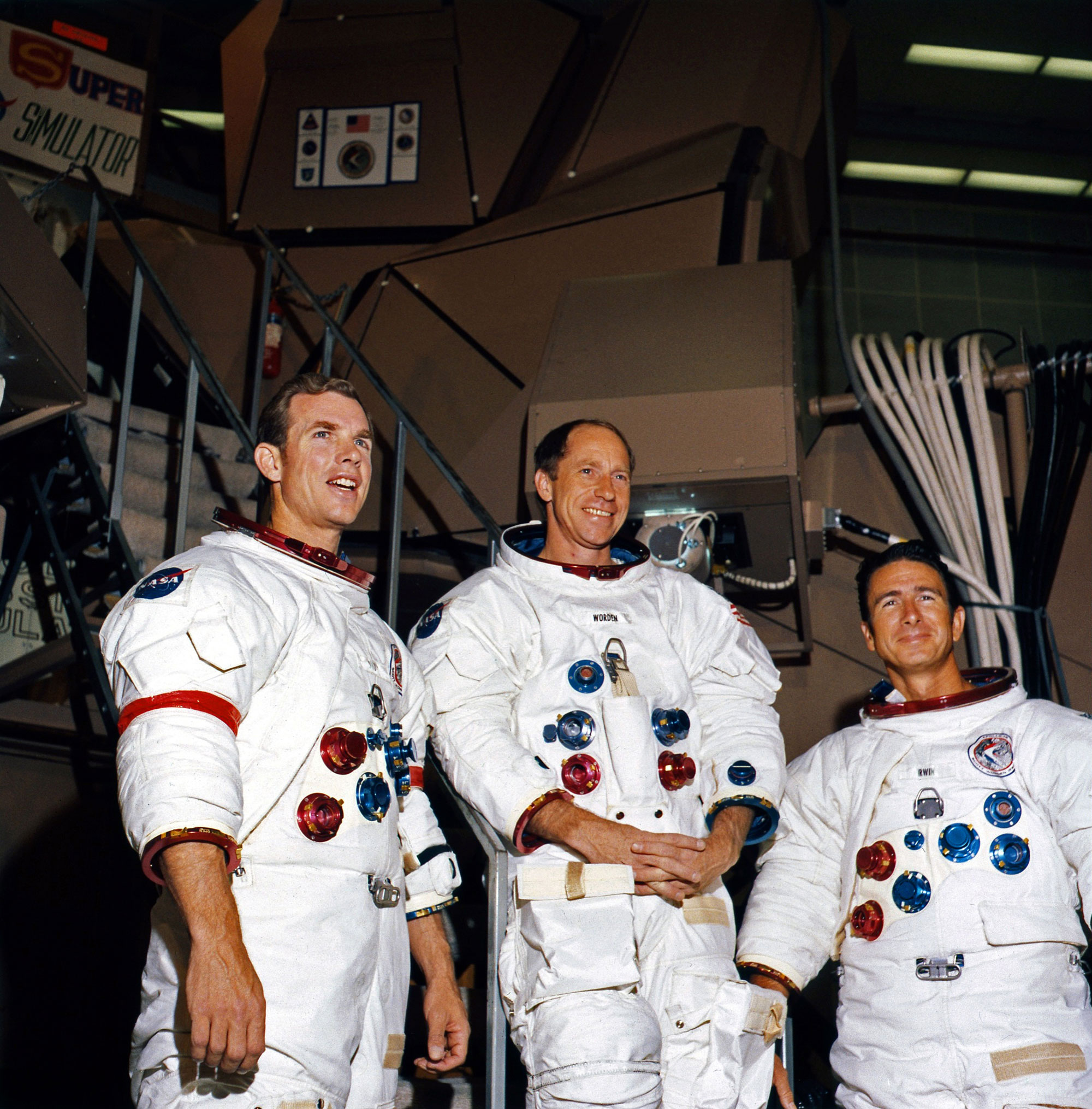
The gravy of the third excursion would be tempered by the fact that it would also be the shortest, scheduled to last barely four and a half hours. It started with the recovery of a core sample from EVA-1. For a few moments, their efforts to extract the core tube from the ground were fruitless and Scott was almost ready to give up. However, with Irwin’s persuasion, both men hooked an arm under each handle of the drill and after several firm tugs the tube sprang from the ground.
Precious minutes were wasted, though, when the vice carried on the rover to dismantle the tube into storable sections proved to have been fitted backwards; Irwin broke out a wrench and used that, but Scott’s frustration was evident. He knew that for every minute wasted before the drive started, they would lose at least another two minutes of geological exploration.
Some of the senior NASA managers in Mission Control wanted to abandon the core entirely. However, the astronauts and Joe Allen had an ally in Flight Director Gerry Griffin, who had shared several of their geological trips in the California mountains and knew how important the science was…and how important the deep core sample was to the success of this mission. It was he who persuaded the managers not to abandon the core tube work.
After they had partially disassembled the tube, it was decided that they should leave the remainder of the task to later. When the core was finally opened on Earth, it proved to contain several dozen layers which documented some 400 million years’ worth of lunar history…
At length, Scott and Irwin buckled into the rover and headed west-northwest for a good look at Hadley Rille. After the rille, if time permitted, they hoped to grab an opportunity to inspect the mysterious “North Complex” of craters, which some geologists thought might be a cluster of small, ancient volcanoes.
Their arrival at Hadley Rille was truly breathtaking. Its far wall, bathed in the harsh, direct sunlight of the late lunar morning, showed distinct layers of rock pushing through a mantle of dust, lending credence to theories that Mare Imbrium had been built up as a succession of ancient lava flows.
One theory was that the rille was a fracture where the mare surface “opened” like a cooling joint. “But since the scientists have studied the pictures,” Irwin wrote, “the most popular theory is that Hadley Rille was probably a lava tube that collapsed.”
All around the two men were enormous slabs of basalt and the geologists in the back room in Houston quickly began pressing for them to move further downslope, though Joe Allen was becoming nervous. Looking at televised pictures, it seemed to him as though they were right on the edge of a precipice.
In fact, the rille had no dramatic “drop”; rather, it resembled the gentle shoulder of a hill, and they were able to walk downslope without difficulty. “In fact,” Scott wrote, “the slope down which we descended was only about 5-10 degrees and the maximum slope of the rille was only 25 degrees—not steep for such a canyon-like formation.” It was steep enough, however, that from their vantage point they were unable to see the floor.
Time was escaping them (it was “relentless”, Apollo 15 backup commander Dick Gordon once said), and any chance to explore the North Complex very quickly disappeared; that would have to await another generation.
Both astronauts found this bitterly disappointing: in Irwin’s mind, it left their excursion only half-complete, whilst Scott would wonder for years afterward if the unique data from the deep core was really worth abandoning the chance to visit the North Complex. At the same time, they appreciated the urgent need to get back to Falcon with enough time to prepare for liftoff later that day.
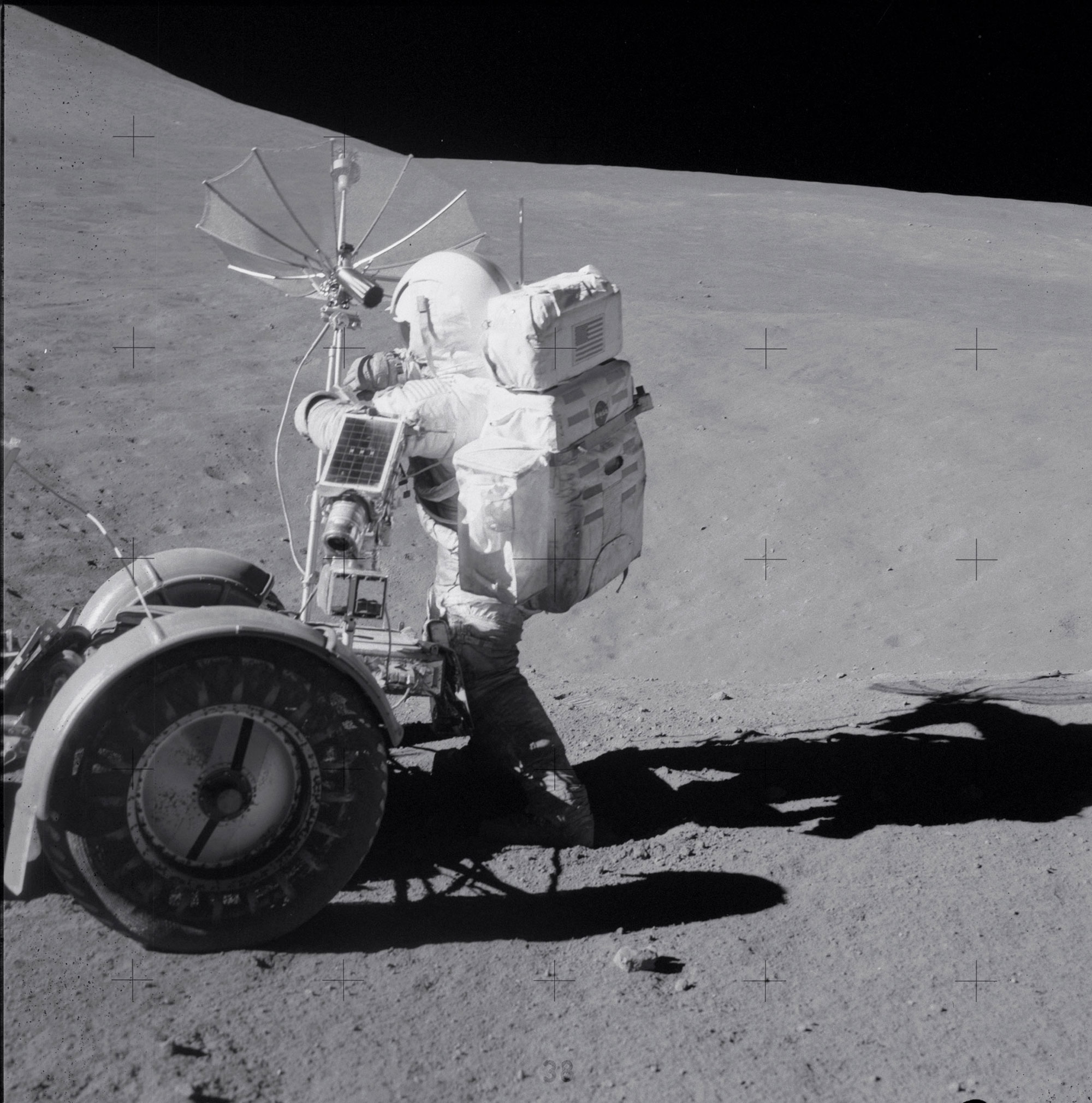
Credit: NASA via Retro Space Images
Back at the lander, with the minutes of the final Moonwalk rapidly winding down, Scott had one last opportunity to give a scientific demonstration to an audience of millions back home. It came from a suggestion by Joe Allen, who was inspired by the experimental work of the great Italian scientist, Galileo Galilei.
More than three centuries earlier, Galileo had stood atop the Leaning Tower of Pisa and dropped two weights of different sizes, proving that gravity acted equally on them, regardless of mass.
Now, in front of his own Leaning Tower—the slightly-tilted Falcon—Scott performed his own version of the experiment.
“In my left hand, I have a feather,” he told his audience, “in my right hand, a hammer. I guess one of the reasons we got here today was because of a gentleman named Galileo a long time ago, who made a rather significant discovery about falling objects in gravity fields. The feather happens to be, appropriately, a falcon’s feather, for our Falcon, and I’ll drop the two of them here and hopefully they’ll hit the ground at the same time.”
They did…and applause echoed throughout Mission Control.
“How about that?” Scott concluded triumphantly. “Mr Galileo was correct in his findings!” He originally planned to try it first, to check that it would work, but was worried that it might get stuck to his glove. He decided to “wing it” and, thankfully, it worked.
In his autobiography, Irwin would relate that Scott had actually carried two feathers on Apollo 15, one from the falcon mascot at the Air Force Academy. Unfortunately—and much to Scott’s irritation—Irwin accidentally stepped on it! They searched for the feather, but could only find his big bootprints. “I’m wondering,” wrote Irwin, “if hundreds of years from now somebody will find a falcon’s feather under a layer of dust on the surface of the Moon and speculate on what strange creature blew it there.”
Shortly after 9:00 p.m. EDT on 2 August, a little more than four hours since setting foot on the surface for EVA-3, Scott drove the rover, alone, to a spot a few hundred feet east of the lander.
From this place, Mission Control would be able to remotely operate its television camera to record the liftoff of Falcon’s ascent stage. Scott pulled out a small red Bible and placed it atop the control panel of the rover, in order to show those who followed in their footsteps why they had come.
Next, he climbed off the machine and strode toward a small crater. He dug a small hollow and dropped a small aluminum figurine of a fallen astronaut onto the lunar soil. The tiny figurine had been arranged by Apollo 15 command module pilot Al Worden. Meanwhile, Jim Irwin had organized a small plaque, planted alongside, listing the names of 14 astronauts and cosmonauts known to have died doing their duty. The list included Yuri Gagarin, the first man in space, together with Vladimir Komarov and the crews of Apollo 1 and Soyuz 11.
As he gazed on the plaque, Scott knew he would never come here again. “I had come to feel a great affection for this distant and strangely beautiful celestial body,” he later wrote in his memoir, Two Sides of the Moon. “It had provided me with a peaceful, if temporary, home. But it was time to return to my own home back on Earth.”
Within the confines of Falcon, they had little time to gaze out at the spectacular site of Hadley; only a few hours remained before their 1:11 p.m. EDT liftoff, bound for a rendezvous with Al Worden in the command module Endeavour.
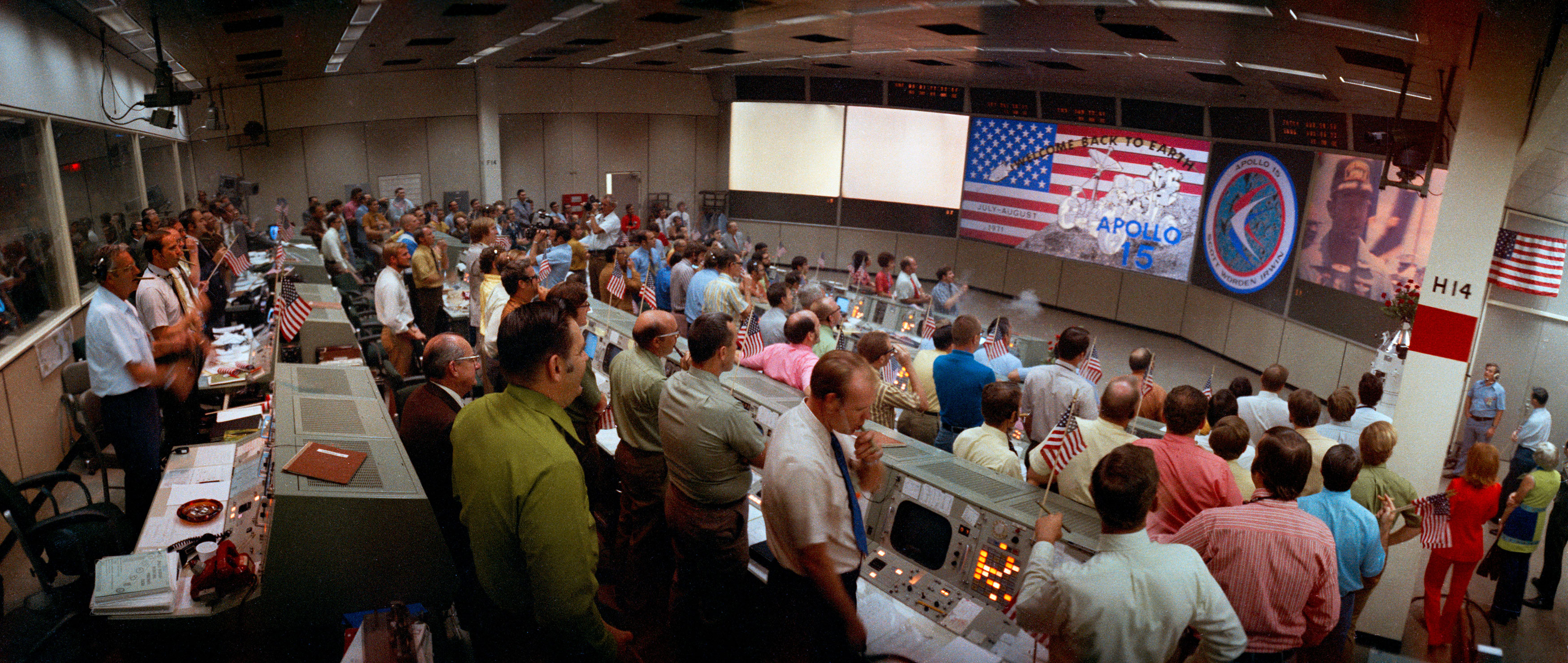
It marked the first occasion on which a crew would complete a moonwalk and perform the liftoff and rendezvous without a rest period in between the two. Having been outside for less than five hours on EVA-3, Irwin wished that Mission Control could have postponed the inevitable by several hours to have enabled them to drive home by way of the North Complex and gather a few samples. Sadly, it was not to be.
Precisely on time, Scott punched the Abort Stage button and a television audience back on Earth had the chance to actually see an Apollo crew leave the Moon. Falcon’s ascent stage literally “popped” away from the descent stage and shot directly upwards with all the speed and accuracy of an express elevator, spraying a shower of fragments of insulation radially outwards.
One journalist would later compare it to something left over from a Fourth of July celebration. Watching from Mission Control, Chris Kraft—then serving as deputy director of the Manned Spacecraft Center (MSC), today’s Johnson Space Center (JSC) in Houston, Texas—would gape at the speed of the departure. “I had no idea it went so fast,” he wrote in his autobiography, Flight. “We’d been told it was like that by the other Moon crews, but seeing it for real was a thrilling shock.”
Ten seconds later, a strangely familiar sound came into Scott and Irwin’s earpieces: The Air Force Song, courtesy of Worden, which they had intended to play to Houston only, but which somehow ended up being routed to Falcon, as well. “This was kind of surprising,” wrote Irwin, “because Dave had briefed Al to turn on that music at one minute after liftoff (that first minute is rather critical) but here it came at ten seconds. It really caused some consternation in Houston. First, they thought somebody was playing a trick in Mission Control, so they conducted a big search. They asked for radio silence – it was a tense situation. Finally, they realised that probably we had turned it on.”
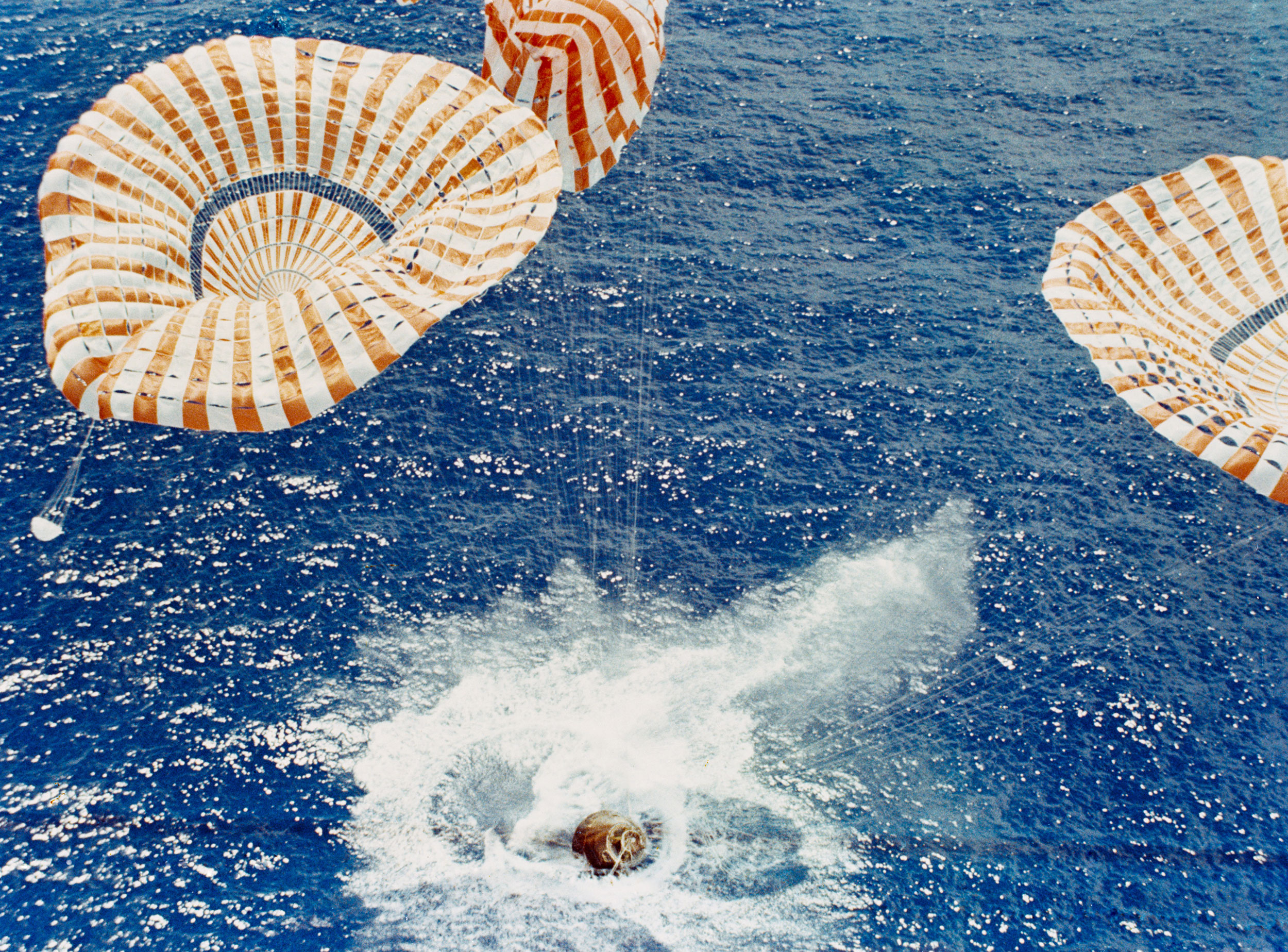
Several days later, on 7 August, Endeavour splashed down safely in the waters of the Pacific Ocean, bringing the lunar explorers safely back to Mother Earth.
The months which followed would be challenging for them all. Initially assigned as the backup crew for Apollo 17 – the final lunar landing mission – they were abruptly removed from flight status in April-May 1972 and replaced by John Young, Stu Roosa and Charlie Duke. The reason stemmed from their carriage of four hundred unauthorised first-day covers, the proceeds of which were to be invested into trust funds for their children.
Although the agreement with a German stamp dealer went awry within weeks of splashdown and none of the Apollo 15 astronauts accepted any money, they were harshly criticised by NASA and some members of Congress, who demanded an investigation into “improper conduct”. Although none of them had done anything wrong or illegal, they were stripped of flight status and Scott fumed that NASA did nothing to dispel (untrue) rumours that they had been fired.
Forty-four years after the remarkable scientific extravaganza of Apollo 15 – a mission which unveiled more of the Moon’s mysteries than ever before – it is saddening that this incident continues to resonate.
However, the exploration of Dave Scott, Al Worden and Jim Irwin serves one other purpose: to whet the appetites of future lunar explorers, awaiting their chance to visit the mountains of the Moon once again.

